Our neighbor mentioned one day that the local market was having a great sale on cheddar cheese. Dave suggested we buy several pounds to take advantage of the price. I include cheese in many of our meals but not enough to consume that much before it would start to go bad. Then during one of our church get-togethers, another neighbor mentioned that you can preserve cheese in wax. I had seen wax-covered cheese in the deli’s and grocery stores all my life but had never thought much about it. I thought it was a marketing gimmick or something.
We decided to buy a five pound block of red cheese wax from New England Cheesemaking Supply Company, and it arrived in just a few days:
The instructions called for a double-boiler in order to not burn the wax, so I dutifully went out and bought one. That was my first mistake. They said you should have dedicated utensils and containers because working with wax pretty much ruins them for other uses. I then asked myself, “What was I thinking. Why would I want to ruin a brand new double boiler for this use??!” I decided to keep the double boiler because I didn’t have one and it is an integral component of good kitchen utensils. So I ended up putting water in the bottom of the double boiler and setting in it an old stainless steel bowl which ended up working just as well. I hope to find a used large saucepan at a thrift store in which to put the steel bowl for a makeshift double boiler in any future cheese waxing:
I cut a small block of wax off of the large block and placed it in the bowl to start melting:
It really didn’t take long for the wax to melt at a low heat:
At first I tried using tongs to hold the cheese as I dipped it, but that seemed to be a bit slippery, and the cheese ended up being dropped. Also, we had purchased a cheese wax brush to dip and brush the wax onto the cheese. That was my second mistake. The brush proved to be pretty useless because it didn’t provide for a thorough coating, and the process was very time consuming. Dave suggested perhaps cutting the cheese (alright, enough snickering) into smaller sizes and dipping them in half at a time with clean hands, letting that dry, and then dipping the remaining half. That seemed to work really well:
The instructions called for two to three coats of wax, but since this was my first time, I wanted to coat them really well; so I ended up dipping them about four times. It took only seconds between each dipping for the coating to dry:
Here is the final product ready to be stored for several months!
We figured in storing the cheese it would be best to keep it as far away as possible from any potential mice, so we purchased a few inexpensive hanging baskets and hung them containing the cheese in our root cellar:
I have used a few blocks of the cheese so far, and the wax has proven to work beautifully. It comes off very easily and can be washed, melted and re-used. I highly recommend this method of cheese preservation and thank God for His continued provisions.
Susan
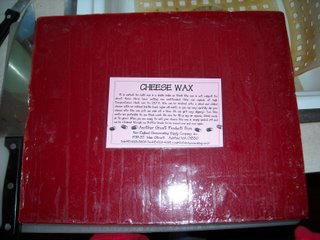
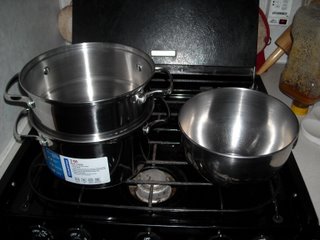
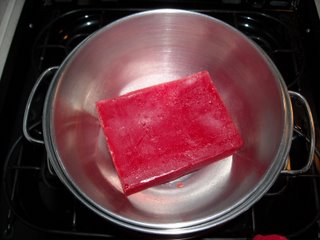
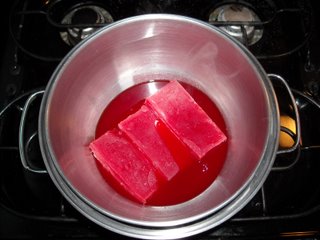
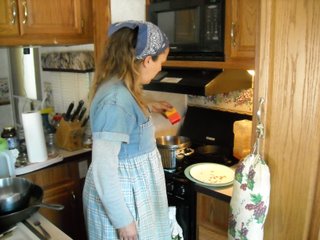
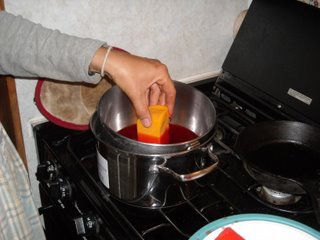
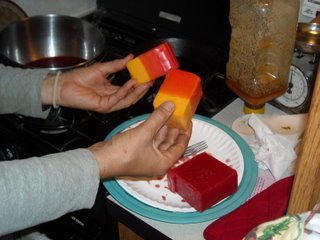
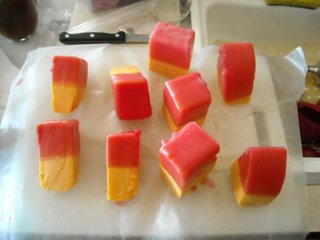
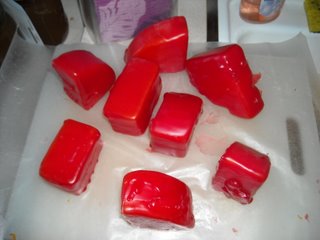
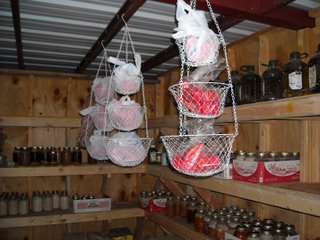
What a great idea… I just keep learning and learning from you! I really like cheese and this would be great to do. Can’t wait to see what comes next!
Debylin
Neat! Though I know parrafin can be used on top of homemade jams, etc. in canning jars, and have seen/bought waxed cheeses, I didn’t fully know it would preserve cheese. Makes sense though. Good point that the wax can be washed and remelted. I’ve thought about that as I’ve taken wax off jam or off cheese, but haven’t done it. Since we’re still on grid (and even with a generator I’d use it yet), we have an old model Foodsavor that keeps cheese fresh at frig. temp for ages. The jar suction attachment for wide mouth canning jars, could be used with cheese blocks put in the jars for mouse protection too, I would think; and them put in my root cellar. I’ve recently invested in 2 cases of 2 quart jars at Woodmans for food storage/bug protection in my cupboards of such things as baking chips, coconut, walnuts, pecans etc. Have used qt. jars for ages for lentils, beans etc. With the air sucked out, things stay fresh indefinitely and bug free. Nice.
I may send for some wax and give this a try! Was just down in my root cellar yesterday checking the temp/humidity…I’d let cool night air in at ground level for 2 + nights and the vent window at ceiling height was open. It was 35degrees and 75% humidity yet. So I shut down the inlet/vent.
In summer what temp. and humidity does your root cellar average? Just curious. Thanks again for the idea!! (I only snickered cause you said not to, Susan! Ha!)
Beth
That looks beatiful! Before wax, cheese was sewed up in muslin and coated with butter. You rub butter over the muslin-covered cheese and then put it in a cool, airy place. Each day, rub more butter on it and turn it. After a while, you will have a nice rind which could get some nice mold, which would enhance the flavor of the cheese. The nifty thing about aging cheese like that is that you will have your own unique molds and your own unique cheese. I don’t know if it would work with store-bought, pasteurized, preservative-filled cheese, though.
Keep up the good work!
😀
Thanks very much for all of the great info. and comments.
Beth, I like the idea of preserving things from pests in canning jars. I may try that for some dried goods. I’ll have to get back to you on the root cellar average summer temp. and humidity since this will be the first full summer of having the root cellar functional and insulated by the summer kitchen structure above it.
Susan
What a neat idea. When we lived in Florida, we could buy red waxed cheese at one of the more “country” grocery stores. The cheese came in wedges that had been sliced off the wheel. There was one layer of cheesecloth, then the red wax. I’m wondering if the cheesecloth helped the wax to adhere, as the cheesecloth was “glued” into the wax.
Beverly
Hi Noelle,
Thank you for your comment! I'm glad this post is of help to you and I hope your cheese waxing endeavors are successful.
Thanks again!
Susan
Thanks for the info and pictures. I appreciated how you posted your mistakes. It sounds like ones I would have made and now I can just learn from your experience. I recently heard about canning cheese, but this sounds a lot easier. I also like how you cut the cheese in smaller portions. It would be easier to use a small amount. Thanks again!!! I am a Mormon and I LOVE all this Be prepared stuff as we have been encouraged to have a year supply of food.
Hello! Very interesting post. How did this work in the long run? I have heard of others having problems with the cheese releasing oils which pooled under the wax and compromised the wax’s integrity. Did you have any problems with this? I’ve also read that if you’re waxing your own fresh cheese it needs to air out for a while to dry and then it is treated with a salt water brine prior to waxing. Any thoughts? I will be using store bought cheddars. I want to give this a try and would rather not waste cheese in the process. 🙂 Thanks in advance!!
Hello Anonymous!
Thanks for stopping by our blog! To be honest, we have not preserved cheese this way since I wrote this blog post, however, this method worked out very well in the long run. I remember the cheese lasted several months down in our root cellar. Towards the end, I remember something was starting to compromise, like a little mold was forming in places where the wax was thin, or something like that. It certainly could have been the oil issue you mention in your message. These were just your regular,one pound, blocks of store-bought cheddar cheese. But, for the most part, it was a very worthwhile way to preserve it. I think, ultimately, the price of the wax may have been the main deterrent to doing it on a regular basis for us, personally. When we have had extra goat milk from milking our goats, I have made, on occasion, fresh farmer cheese, seasonally.
I hope this works well for you if you try it!
Susan